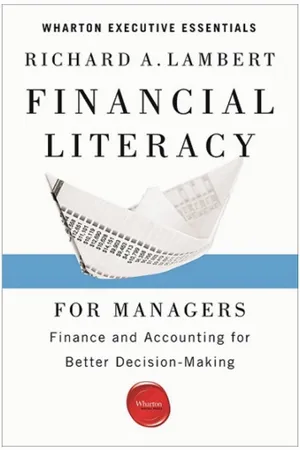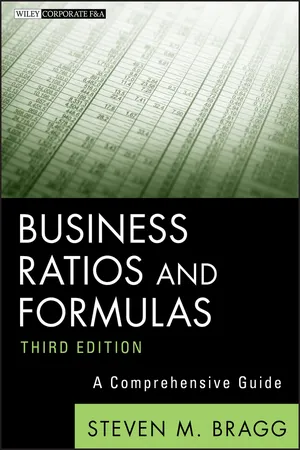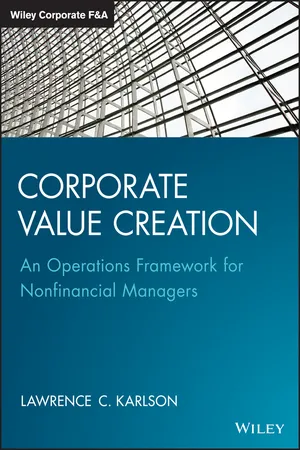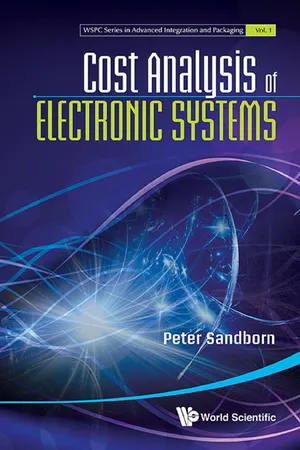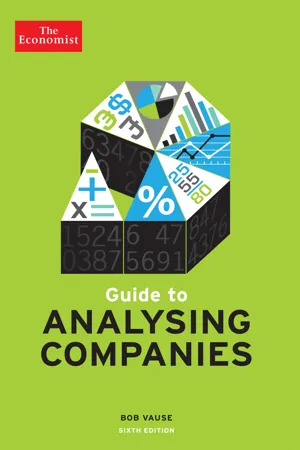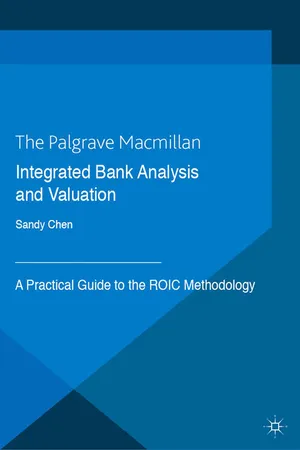Business
Return on Equity
Return on Equity (ROE) is a financial metric that measures a company's profitability by evaluating how effectively it generates profit from shareholders' equity. It is calculated by dividing net income by shareholders' equity. ROE is a key indicator of a company's financial health and its ability to generate returns for its shareholders.
Written by Perlego with AI-assistance
Related key terms
Related key terms
1 of 4
Related key terms
1 of 3
7 Key excerpts on "Return on Equity"
- eBook - ePub
- Richard A. Lambert(Author)
- 2016(Publication Date)
- Wharton Digital Press(Publisher)
all the suppliers of capital—both investors and creditors. How much of this do shareholders get? The answer depends on the capital structure of the firm; that is, the mix of debt and equity. Debt holders supply some of the capital the firm uses to acquire assets. In return, some of the money that the assets generate goes to debt holders in the form of interest payments. Shareholders get the rest. We call the return the shareholders get on the amount they invested the firm’s Return on Equity (ROE), which is defined as:The profitability measure is Net Income; this is the return that goes to the shareholders. Similarly, the investment measure is what has been provided by shareholders. As with ROA, it is preferable to use the average balance for Stockholders’ Equity throughout the period in order to take into consideration the inflow or outflow of shareholders’ investment throughout the period.A Benchmark for ROE: Cost of Equity Capital
What’s the relevant benchmark for an acceptable ROE? Because there are no explicit payments owed to equity holders, a common misconception is that equity capital is free. This is completely wrong; the relevant rate of return is the amount that shareholders could get in the marketplace for investments with identical risk. Because the claims of debt holders get paid first, equity is a riskier claim than is debt. Therefore equity investors demand a higher rate of return as compensation for this risk; equity capital is more expensive than debt capital. This means the benchmark for ROE is generally higher than the WACC.There is less agreement as to how to measure risk from the perspective of equity holders than there is for debt holders. One of the most widely used approaches, called the Capital Asset Pricing Model (or CAPM for short), is based on the idea that some risks are diversifiable and some are not. Diversifiable risks are those that can be greatly reduced (or even eliminated) by shareholders by holding a well-diversified portfolio of firms. Therefore, these risks are not priced in the marketplace; shareholders do not demand an extra premium to invest in firms whose profits are affected by these kinds of risks or uncertainties. - eBook - ePub
Business Ratios and Formulas
A Comprehensive Guide
- Steven M. Bragg(Author)
- 2012(Publication Date)
- Wiley(Publisher)
By avoiding the opinions of the production staff and relying instead on a quantitative comparison of capacity levels and available equipment, the CFO has determined that there are three extra band saws and five extra belt sanders, with a combined cost of $85,000. With this information, the CFO calculates the return on operating assets as:Cautions: The specific assets included in the denominator can be subject to a great deal of interpretation, since managers realize that any assets not included in it will eventually become targets for elimination. The list of assets used should consequently be carefully reviewed, preferably with the industrial engineering staff, to ensure that each asset has a direct role in the production of revenue.Return on Equity PERCENTAGEDescription: This calculation is used by investors to determine the amount of return they are receiving from their capital investment in a company. This is a commonly used measure, but can be misleading, as discussed in the Cautions section.Formula: Divide net income by total equity. To obtain a better picture of the ability of a company to generate a return from operating activities only, the measure can be modified to be net income from operations divided by total equity. The basic formula is:Example: The president of the Lounger Chairs Furniture Company has been provided with a bonus plan that is largely based on the increase achieved on Return on Equity for the shareholders. There is $1,000,000 of equity on the books, of which $400,000 is closely held and the other $600,000 is held by a variety of small investors. The president estimates that it will be possible to buy back $300,000 of the stock from small investors by obtaining a loan that has an after-tax interest rate of 8%. The president compiles the information in Table 7.3 to see if the stratagem makes sense.TABLE 7.3Before Stock Buyback After Stock Buyback Sales $5,000,000 $5,000,000 Expenses $4,850,000 $4,850,000 Debt interest expense — $24,000 Profits $150,000 $126,000 Equity $1,000,000 $700,000 Return on Equity 15% 18% The strategy appears to be a good one. Though expenses will be driven up by the interest cost of the debt, the amount of equity will be reduced to such an extent that the Return on Equity will increase by 3%. Before implementing this strategy, though, the president should investigate the company's ability to generate enough cash flow to pay off or at least maintain the debt. - No longer available |Learn more
Corporate Value Creation
An Operations Framework for Nonfinancial Managers
- Lawrence C. Karlson(Author)
- 2015(Publication Date)
- Wiley(Publisher)
CHAPTER FIVEROCE and Cash Flow Analytics*CHAPTER 5 TAKEAWAYS
- “We need to start making some serious money around here to improve the ROCE because anything we do to improve the balance sheet is ‘one time,' whereas profits with momentum will continue to grow.”
- EBIT/Rev is a definition of Return on Revenue and a measure of how effective the management of a company is in converting Net Revenues into Earnings before Interest and Taxes.
- Rev/CE is a definition of Capital Turnover and a measure of how well the managers of a company manage the capital employed in the company.
- ROCE is a measurement of value created and important because it compares what the management of a company is capable of delivering (Earnings before Interest and Taxes) to what has been invested in the business (Capital Employed). In practice the situation isn't quite that simple, because, in addition to the absolute value of ROCE a management team can deliver, investors are also concerned with the quality of earnings and risk. Therefore, even if a management team maximizes its ROCE, it may not be rewarded by the marketplace unless it has also taken actions to deal with some of the other issues that go into evaluating how good the ROCE really is.
- Simply because a company has a good Return on Capital Employed doesn't mean that investors will be looking to own the company's stock. Often high returns are correlated with high risk and, therefore, management must be able to convince investors that not only are the returns they talk about at investor conferences possible but they are also sustainable.
- Outside investors always have alternatives, so that while having the prospect of an attractive ROCE to offer to investors is necessary for a company to attract capital, it is not necessarily sufficient. It's also important to be attractive compared to what else is out there in the same asset class. Furthermore, if the capital available to your asset class from investors familiar with your market segment is insufficient, then you have the additional task of creating interest from investors who don't normally invest in your industry.
- eBook - ePub
- Peter Sandborn(Author)
- 2012(Publication Date)
- WSPC(Publisher)
Chapter 17RETURN ON INVESTMENT (ROI)When managers consider spending money they usually want to formulate a business case that not only describes the process they wish to follow, but also the value that they expect to gain through the investment. For electronic systems manufacturing and life-cycle support, business cases could be required for spending money to modify a manufacturing line, refresh the design of a system, add or expand product or system management activities, or adopt a new technology. One common way to quantify the value is to compute a return on investment (ROI) for a given use of money.While the formulation of an ROI associated with investing money in a financial instrument is straightforward, the calculation of an ROI associated with the generation of an increase in the customer base, cost savings, or future cost avoidance is not as simple to perform. This chapter discusses the formulation and application of ROIs to activities relevant to electronic systems manufacturing and management.17.1. Definition of ROI1A rate of return is the benefit received from an investment over a period of time. Generally returns are ratios relating the amount of money that is gained or lost to the amount of money risked. Return on investment (ROI) is the monetary benefit derived from having spent money on developing, changing, or managing a product or system. ROI is a common performance measure used to evaluate the efficiency of an investment or to compare the efficiency of a number of different investments. To calculate ROI, the benefit or gain associated with an investment is divided by the cost of the investment and the result is expressed as a percentage or a ratio:The second equality in Equation (17.1) is the form that the finance world uses to express ROI, where Vf and Vi are the final and initial values of an investment, respectively. The quantity behind the second equality is also known as a single-period arithmetic return. The quantity expressed in Equation (17.1) is the true rate of return on an investment that generates a single payoff after one period (where the period is the length of time over which the value is measured).2 - Bob Vause(Author)
- 2014(Publication Date)
- Economist Books(Publisher)
Which figure to take from the balance sheet to represent the shareholders’ stake or investment in the business is more problematic. In most balance sheets the shareholders’ total funds are defined as equity. Preference shares or other non-voting capital are often found within the figure for equity. Strictly, these should be removed in the calculation of shareholders’ returns, because it is only the ordinary shareholders, the owners of the company, that are being considered here, not other providers of long-term finance and capital.The figure for shareholders’ funds may have several different labels attached to it: Net assets = total assets – (current liabilities + debt) Capital employed = net assets Equity = capital employed Equity = capital employed = net assets Once the shareholders’ investment has been identified it is possible, using the after-tax profit, to calculate an appropriate rate of return. This rate of return may be defined as:- return on capital (ROC);
- return on capital employed (ROCE);
- return on shareholders’ funds (ROSF);
- Return on Equity (ROE);
- return on investment (ROI);
- return on net assets (RONA).
Earnings per shareInvestors often make use of earnings per share (EPS) as a measure of the overall profitability of a company. EPS is normally to be found in the income statement (see Chapter 3 ). As with any pre-calculated ratio appearing in an annual report, care should be taken to discover precisely how it has been derived. Also remember EPS is backward looking as it is based on historical profitability. The basis of an EPS calculation is:EPS = after-tax profit ÷ the number of shares in issueThis effectively links profit with a single share. If you owned one company share, how much profit did the company earn – but not necessarily pay out – for you in the year? Inevitably problems can arise in defining what income was really available to shareholders and how to define a share. IAS 33 (similar to FAS 128) deals with the calculation and presentation of EPS figures. Earnings is defined as the after-tax profit (less any minority interests and preference dividends) for the year – the profit attributable to ordinary shareholders.- Peter Sandborn(Author)
- 2016(Publication Date)
- WSPC(Publisher)
Chapter 17
Return on Investment (ROI)
When managers consider spending money they usually want to formulate a business case that not only describes the process they wish to follow, but also the value that they expect to gain through the investment. For electronic systems manufacturing and life-cycle support, business cases could be required for spending money to modify a manufacturing line, refresh the design of a system, add or expand product or system management activities, or adopt a new technology. One common way to quantify the value is to compute a return on investment (ROI) for a given use of money.While the formulation of an ROI associated with investing money in a financial instrument is straightforward, the calculation of an ROI associated with the generation of an increase in the customer base, cost savings, or future cost avoidance is not as simple to perform. This chapter discusses the formulation and application of ROIs to activities relevant to electronic systems manufacturing and management.17.1Definition of ROI1
A rate of return is the benefit received from an investment over a period of time. Generally returns are ratios relating the amount of money that is gained or lost to the amount of money risked. Return on investment (ROI) is the monetary benefit derived from having spent money on developing, changing, or managing a product or system. ROI is a common performance measure used to evaluate the efficiency of an investment or to compare the efficiency of a number of different investments. To calculate ROI, the benefit or gain associated with an investment is divided by the cost of the investment and the result is expressed as a percentage or a ratio:The second equality in Equation (17.1) is the form that the finance world uses to express ROI, where Vf and Vi are the final and initial values of an investment, respectively. The quantity behind the second equality is also known as a single-period arithmetic return. The quantity expressed in Equation (17.1) is the true rate of return on an investment that generates a single payoff after one period (where the period is the length of time over which the value is measured).2- eBook - ePub
Integrated Bank Analysis and Valuation
A Practical Guide to the ROIC Methodology
- S. Chen(Author)
- 2013(Publication Date)
- Palgrave Macmillan(Publisher)
In understanding what makes a bank tick, we have found it useful to break down the return on invested capital analysis into two main parts: (1) the bank’s operating performance on a risk-adjusted basis (measured as underlying returns on risk-weighted assets, RORWAs), and (2) its capital leverage (measured as RWA/Invested Capital). Multiplying these two factors together gives us Return on Invested Capital (ROIC).In many ways, this echoes a DuPont-style ROE analysis. The DuPont approach breaks down ROE (Return on Equity) into its main components with the following formula: DuPont ROE decomposition:
Where Net Income/Sales is the net profit margin, Sales/Total Assets is the asset turnover, and Total Assets/Shareholders’ Equity is the leverage component. Similarly, the ROIC approach breaks down ROIC (return on invested capital) into its main components with the following formula: ROIC decomposition:ROE = (Net Income/Sales) × (Sales/Total Assets) × (Total Assets/Shareholders’ Equity)
Where Net Returns/Risk-Weighted Assets is the net risk-adjusted profit margin, and Risk-Weighted Assets/Invested Capital is the capital leverage component.ROIC = (Net Returns/Risk-Weighted Assets) × (Risk-Weighted Assets/Invested Capital) Looking at it in this way, analysing bank performance tends to be a discussion of either (1) what‘s driving changes in operating performance (RORWA components), or (2) whether capital leverage (RWA/Invested Capital ratios, and within Invested Capital the debt capital/equity capital funding mix) is rising or falling. We have found this a simpler, clearer way of analysing a bank’s performance.The fundamental link between analysis and valuation: value creationThe key link between analysis and valuation in the ROIC methodology is value creation (or destruction). If a bank’s return on invested capital (ROIC) is higher than the cost of that capital (WACC), then it is deemed to be creating value in that period; if its ROIC is below its WACC, it is deemed to be destroying value.The ROIC methodology adds up a bank’s future value creation/destruction period-by-period, discounting it back to net present value. This net present value of future value creation/destruction is then added to (or subtracted from) current invested capital to derive a fundamental valuation for the bank.
Index pages curate the most relevant extracts from our library of academic textbooks. They’ve been created using an in-house natural language model (NLM), each adding context and meaning to key research topics.
Explore more topic indexes
Explore more topic indexes
1 of 6
Explore more topic indexes
1 of 4
